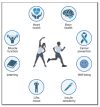Omics Sciences in Regular Physical Activity
- PMID: 40564993
- PMCID: PMC12193621
- DOI: 10.3390/ijms26125529
Omics Sciences in Regular Physical Activity
Abstract
The multiple health benefits of regular physical activity are well known and are the results of exercise adaptations. The study of physical training biology is not straightforward since it involves organ crosstalk and depends on numerous variables, such as type of exercise or individual physiology. A multiomic approach allows us to analyze proteins, metabolites, lipids, and epigenetic modifications on a wide scale, so it is a valid tool to identify numerous patterns and clarify how exercise exerts its beneficial effects. Stimuli given by physical activity lead the body to re-establish a new dynamic balance at the level of redox homeostasis and metabolic state. Evaluating the effect of specific training is important for maximizing the beneficial effects of physical activity. In this review we provide a brief overview of different omics technologies used in this field. For each "omics" we analyzed studies published in the last 10 years and highlighted the main molecules identified with that approach. We then described future challenges in their application from the perspective of using new bioinformatics and artificial intelligence tools.
Keywords: exercise; exercise adaptation; multiomics; systems biology.
Conflict of interest statement
The authors declare that they have no financial/personal interests that could influence the work reported in this paper.
Figures





Similar articles
-
Interventions for promoting habitual exercise in people living with and beyond cancer.Cochrane Database Syst Rev. 2018 Sep 19;9(9):CD010192. doi: 10.1002/14651858.CD010192.pub3. Cochrane Database Syst Rev. 2018. PMID: 30229557 Free PMC article.
-
Signs and symptoms to determine if a patient presenting in primary care or hospital outpatient settings has COVID-19.Cochrane Database Syst Rev. 2022 May 20;5(5):CD013665. doi: 10.1002/14651858.CD013665.pub3. Cochrane Database Syst Rev. 2022. PMID: 35593186 Free PMC article.
-
Exercise interventions and patient beliefs for people with hip, knee or hip and knee osteoarthritis: a mixed methods review.Cochrane Database Syst Rev. 2018 Apr 17;4(4):CD010842. doi: 10.1002/14651858.CD010842.pub2. Cochrane Database Syst Rev. 2018. PMID: 29664187 Free PMC article.
-
Physical activity and exercise for chronic pain in adults: an overview of Cochrane Reviews.Cochrane Database Syst Rev. 2017 Apr 24;4(4):CD011279. doi: 10.1002/14651858.CD011279.pub3. Cochrane Database Syst Rev. 2017. PMID: 28436583 Free PMC article.
-
Physical activity and exercise for chronic pain in adults: an overview of Cochrane Reviews.Cochrane Database Syst Rev. 2017 Jan 14;1(1):CD011279. doi: 10.1002/14651858.CD011279.pub2. Cochrane Database Syst Rev. 2017. Update in: Cochrane Database Syst Rev. 2017 Apr 24;4:CD011279. doi: 10.1002/14651858.CD011279.pub3. PMID: 28087891 Free PMC article. Updated.
References
-
- Bull F.C., Al-Ansari S.S., Biddle S., Borodulin K., Buman M.P., Cardon G., Carty C., Chaput J.-P., Chastin S., Chou R., et al. World Health Organization 2020 Guidelines on Physical Activity and Sedentary Behaviour. Br. J. Sports Med. 2020;54:1451–1462. doi: 10.1136/bjsports-2020-102955. - DOI - PMC - PubMed
Publication types
MeSH terms
LinkOut - more resources
Full Text Sources
Medical

